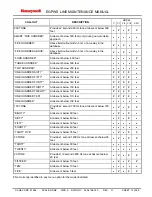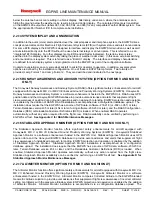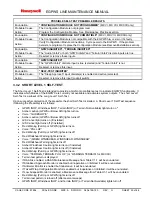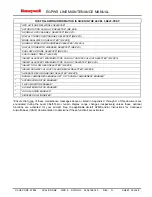
EGPWS LINE MAINTENANCE MANUAL
CAGE CODE: 97896
SCALE: NONE SIZE: A
DWG NO.: 060-4199-180
REV: G
SHEET 20 of 68
2.3 SYSTEM MAINTENANCE
2.3.1 MAINTENANCE
PHILOSOPHY
The EGPWS is an “on-condition” only maintenance system. No scheduled maintenance is required. This is
accomplished by both continuous Built-In-Test (BIT) and event initiated test functions. Event initiated test refers to
both power-up tests and manually activated Self-Tests. Results of these functions are indicated by system status
indicators and messages so that the systems functionality can be assessed.
Detected faults are indicated to the flight crew during normal flight operations by system status annunciators or flight
display (EFIS) messages in the cockpit (i.e., GPWS INOP or FAIL, W/S INOP or FAIL, TERR INOP or NOT
AVAILABLE). On the ground, system status indications are expanded to direct fault isolation to the fault source
whether internal or external to the EGPWC. Several levels of reporting are provided by the EGPWS Self-Test, and
multiple means are provided to access the information. The intent is to provide information that will encourage the
line mechanic to correct the real problem through clear fault messages and minimal effort.
2.3.2 SYSTEM OPERATION DURING AN INOP CONDITION
EGPWS continued airworthiness is predicated on system status indications. An indication of TERR INOP (only) or
NOT AVAILABLE (only) is likely to indicate a loss of necessary GPS data for performing Terrain Alerting and
Display functions, but has no effect on basic GPWS (Modes 1-7) functions. Additionally, a GPWS INOP (only)
indicates a loss of basic GPWS functions, but this could be limited to say Mode 4 only because of a loss of
necessary data required for that mode alone. In any case, the EGPWS will provide alerting based on the current
capability of the EGPWC and its inputs.
For the MK VI and MK XXII, consideration should be given to any operation that will cross the boundaries of the
regional database. Although this has no affect on the basic GPWS functions, the enhanced (TAD/TCF) functions
will become inoperative once the aircraft leaves the database region. This is indicated by the TERR INOP or NOT
AVAILABLE status indicator and the loss of terrain display when enabled and active.
2.3.3 BIT
DESCRIPTION
The EGPWC contains an extensive BIT capability. The BIT functions provide high confidence that the Warning
Computer and interface signal sources are operating properly, and that the EGPWS will perform its intended
function. Detected failures are indicated via GPWS INOP, Windshear INOP, and Terrain INOP/NA annunciations
and on the ARINC 429 bus output. Failures detected during flight are saved in the flight history and are enunciated
during Level 4 of the cockpit Self-Test. BIT status is also available through the RS-232 port by use of a PC or
terminal.
If the EGPWC detects an internal Warning Computer fault, it will turn on all the INOP lights. If the EGPWC detects
an external input fault, it may or may not turn on the INOP light(s) depending on the input fault, the type of
installation, and whether the aircraft is airborne or on the ground.
The EGPWC BIT performs three types of functions: Operation Monitoring, Operation Tests, and Restricted Tests.
Operation Monitoring consists of software checks that are performed as part of the normal Warning Computer
processing. Operation Monitoring includes checks of data values and program flow control variables used for the
warning computations to ensure they are within expected ranges. The statuses of various EGPWC hardware sub-
systems are continuously verified including core processor checks, voice generator circuitry checks, and ARINC
429 wrap-around tests. Operation Monitoring also includes extensive testing of the input signals to ensure the
EGPWC is using proper data for its calculations.
Operation Tests run during normal operation without disrupting the EGPWC warning calculations or annunciations.
Operations Tests include CPU instruction set tests, A/D tolerance tests, ROM check-sum verification tests, and non-
destructive RAM tests. Operation Tests are scheduled by the operating system to be performed between the
routines required for normal operation.
Restricted Tests destroy data or take an excessive amount of time to complete and cannot be run during normal
system operation. These tests are usually run during system power up or during a cockpit initiated Self-Test.
















































